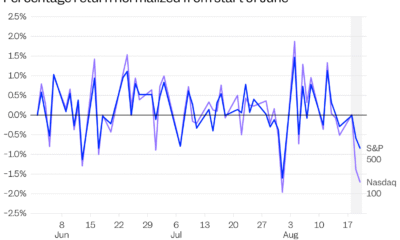AI Research
Clarivate Unveils Enhanced 2025 G20 Research, Innovation Scorecard with Expanded Data, AI Insights

Clarivate (NYSE:CLVT) is one of the cheap IT stocks hedge funds are buying. On July 9, Clarivate released its annual 2025 G20 Research and Innovation Scorecard. This scorecard was developed by experts at the Institute for Scientific Information/ISI at Clarivate and provides a data-driven overview of the research and innovation capabilities of G20 member nations.
The 2025 scorecard now incorporates data from the Emerging Sources Citation Index/ESCI, which is a part of the Web of Science Core Collection, to provide a more comprehensive view of global research. The scorecard has been refined to better emphasize collaboration and impact, reflecting South Africa’s Ubuntu philosophy, the G20 host for 2025.
A state-of-the-art computer lab filled with engineers working on new analytics technologies.
Dynamic visualizations are included to showcase each member’s research performance within their economic context and academic priorities. New additions also include OECD field-level breakdowns, insights into open access, and research aligned with Sustainable Development Goals (SDGs), highlighting how G20 nations are collaborating to address global challenges.
Clarivate (NYSE:CLVT) is an information services provider in the Americas, the Middle East, Africa, Europe, and the Asia Pacific.
While we acknowledge the potential of CLVT as an investment, we believe certain AI stocks offer greater upside potential and carry less downside risk. If you’re looking for an extremely undervalued AI stock that also stands to benefit significantly from Trump-era tariffs and the onshoring trend, see our free report on the best short-term AI stock.
READ NEXT: 30 Stocks That Should Double in 3 Years and 11 Hidden AI Stocks to Buy Right Now.
Disclosure: None. This article is originally published at Insider Monkey.
AI Research
Meet the Artificial Intelligence (AI) Stock With $368 Billion in Revenue Coming Down the Pipeline

Key Points
-
A handful of big tech companies are set to spend over $300 billion building AI infrastructure this year.
-
Demand for compute is growing just as fast as companies can stand up new servers.
-
This giant has more commitments and is growing faster than almost everyone in the market.
- 10 stocks we like better than Microsoft ›
A handful of big tech companies are set to spend over $300 billion building AI infrastructure this year.
Demand for compute is growing just as fast as companies can stand up new servers.
This giant has more commitments and is growing faster than almost everyone in the market.
The artificial intelligence boom is only getting bigger, with just a handful of big tech companies on track to spend over $300 billion on AI infrastructure this year alone. Alphabet (NASDAQ: GOOG)(NASDAQ: GOOGL) recently bumped its capital expenditure outlook for the full year from $75 billion to $85 billion. Amazon (NASDAQ: AMZN) is on track to spend over $100 billion in capital expenditures, mostly going toward new data centers and servers to fill them. And Microsoft (NASDAQ: MSFT) is planning a whopping $10 billion of spending per month for the current quarter.
By far the biggest beneficiary from all that spending has been Nvidia (NASDAQ: NVDA). The chipmaker has seen its data center chip sales soar over the last few years, including a 56% jump in its most recent quarter. And demand doesn’t seem to be slowing down anytime soon, with analysts expecting revenue to grow nearly as much next year as this year (on an absolute basis).
Where to invest $1,000 right now? Our analyst team just revealed what they believe are the 10 best stocks to buy right now. Learn More »
But another AI giant just disclosed it has $368 billion of contracted revenue, and it’s doing everything it can to keep up with the massive demand it’s seeing.
Image source: Getty Images.
Huge long-term commitments give this stock a massive runway
All three major cloud computing platforms disclose their backlog, or remaining performance obligations, and all three are seeing healthy growth.
- Alphabet said its Google Cloud backlog climbed to $108 billion last quarter, a 37% increase from a year ago.
- Amazon said its Amazon Web Services backlog totaled $195 billion, a 25% increase from a year ago.
- Microsoft revealed a $368 billion backlog last quarter, a 37% increase from last year.
Indeed, Microsoft is the AI giant with $368 billion coming down the pipeline.
There’s an important caveat about Microsoft’s remaining performance obligations. It includes contracts for commercial software and services like Microsoft 365 and its Azure cloud computing platform. As such, it’s not a perfect apples-to-apples comparison with Amazon or Alphabet. Still, the growth is impressive, and the metric Microsoft shares suggests Azure may be growing its commitments significantly faster than its two biggest rivals.
Importantly, Microsoft’s backlog growth is stemming from a growing number of long-term commitments. Microsoft said just 35% of those commitments will be recognized as revenue in the next 12 months, with the total increasing 21% year over year. The amount recognized beyond 12 months grew 49%. By comparison, Alphabet saw the percentage of commitments set to be recognized as revenue within 24 months drop from 55% to 50% last quarter. Amazon saw the average length of its long-term commitments get a slight bump from 3.9 years to 4 years.
That shift can skew just how much faster Azure is growing compared to its rivals. If Microsoft is extending the length of its contracts, it’ll naturally have a bigger backlog. Still, the long-term commitments put Microsoft in a position to generate strong growth for Azure for years to come. Management shared that Azure is now a $75 billion business, after exhibiting 39% year-over-year revenue growth last quarter. It expects 37% growth next quarter. That makes it roughly 50% larger than Google Cloud, but growing faster. And its massive backlog means it can continue outpacing the competition in the future.
Demand continues to outpace supply
Microsoft management has been telling investors for well over a year that demand for its cloud computing services, particularly its Azure AI services, is higher than its supply. That remained the case in the fourth quarter. To be sure, that’s not a situation unique to Microsoft. Both Amazon and Alphabet have made similar comments on their earnings calls.
But Microsoft is spending more than anyone building out its data centers. As mentioned, it committed to spending $30 billion on capex this quarter, and management refused to provide guidance on how much it might spend through the rest of fiscal 2026. But given the massive and rapidly growing backlog of demand for its AI services, investors should be happy to see Microsoft build as quickly as possible. It’s important to remember that Microsoft also holds a leading position as enterprises migrate more of their systems from on-premise to the cloud, specializing in hybrid cloud environments using Windows. As such, overbuilding shouldn’t be a huge concern.
Azure is the biggest growth driver for Microsoft right now, but it’s not the only one. As mentioned, that $368 billion backlog also includes commitments for Microsoft 365, Dynamics 365, and Microsoft’s other enterprise software and services. Those are getting a boost from AI as well, as Microsoft integrates its Copilot AI assistant into its software. That helps workers get more out of its products and increases productivity. As a result, Microsoft is able to charge more and gain bigger commitments from commercial customers.
Investors will have to pay a premium price to buy Microsoft stock. With a forward P/E ratio of 32, it trades for a much higher price than Alphabet, which sports a 23 multiple. It’s even approaching Amazon’s 34 times earnings multiple, despite the cloud computing leader historically trading for a much higher earnings multiple. But with a massive pipeline of long-term growth ahead for the company, it’s well worth paying up for.
Should you invest $1,000 in Microsoft right now?
Before you buy stock in Microsoft, consider this:
The Motley Fool Stock Advisor analyst team just identified what they believe are the 10 best stocks for investors to buy now… and Microsoft wasn’t one of them. The 10 stocks that made the cut could produce monster returns in the coming years.
Consider when Netflix made this list on December 17, 2004… if you invested $1,000 at the time of our recommendation, you’d have $670,781!* Or when Nvidia made this list on April 15, 2005… if you invested $1,000 at the time of our recommendation, you’d have $1,023,752!*
Now, it’s worth noting Stock Advisor’s total average return is 1,052% — a market-crushing outperformance compared to 185% for the S&P 500. Don’t miss out on the latest top 10 list, available when you join Stock Advisor.
*Stock Advisor returns as of August 25, 2025
Adam Levy has positions in Alphabet, Amazon, and Microsoft. The Motley Fool has positions in and recommends Alphabet, Amazon, Microsoft, and Nvidia. The Motley Fool recommends the following options: long January 2026 $395 calls on Microsoft and short January 2026 $405 calls on Microsoft. The Motley Fool has a disclosure policy.
The views and opinions expressed herein are the views and opinions of the author and do not necessarily reflect those of Nasdaq, Inc.
AI Research
Artificial Intelligence For Video Surveillance Market

New Jersey, US State: “The global Artificial Intelligence For Video Surveillance market in the Information Technology and Telecom category is projected to reach USD 16.8 billion by 2031, growing at a CAGR of 11% from 2025 to 2031. With rising industrial adoption and continuous innovation in Information Technology and Telecom applications, the market is estimated to hit USD 6.5 billion in 2024, highlighting strong growth potential throughout the forecast period.”
Artificial Intelligence For Video Surveillance Market Size & Forecast 2033
The artificial intelligence for video surveillance market is expected to grow substantially by 2033, supported by rising demand for advanced security and monitoring solutions. AI-powered systems enhance surveillance by enabling real-time analytics, facial recognition, anomaly detection, and automated alerts. Increasing urbanization, smart city projects, and security concerns in public and private sectors are key drivers of adoption worldwide.
Technological innovations integrating AI with cloud storage, IoT devices, and edge computing are improving accuracy and scalability of surveillance systems. Vendors are focusing on developing customizable platforms for industries such as retail, transportation, and critical infrastructure. The emphasis on proactive threat detection and regulatory compliance is further boosting demand. By 2033, the AI for video surveillance market is forecast to reach robust global valuation, driven by continuous innovation and expanding applications across diverse sectors.
Key Players in the Artificial Intelligence For Video Surveillance Market
Hikvision
Dahua
Huawei
Cisco Meraki
Hanwha
ZTE
Honeywell Security
Simshine Intelligent Technology Co. Ltd.
For Further Detail, Download the Sample PDF with Complete TOC, Tables, Figures, Charts, And More @ https://www.marketresearchintellect.com/download-sample/?rid=1031128&utm_source=OpenprJune&utm_medium=023
Factors Supporting Growth of Artificial Intelligence For Video Surveillance Market in the Future:
1.Technological Advancements and Innovation:
The continuous evolution of technology is playing a vital role in driving the Artificial Intelligence For Video Surveillance market forward. Cutting-edge innovations are improving product functionality, enhancing performance, and reducing costs, making these solutions more accessible to a broader range of industries. Emerging technologies such as AI, IoT, advanced analytics, and automation are also enabling smarter and more efficient use cases, further expanding the scope of the market. These advancements are not only upgrading existing systems but are also creating entirely new application opportunities that will support long-term market expansion.
2. Expanding Applications Across End-Use Sectors:
The increasing integration of Artificial Intelligence For Video Surveillance solutions across diverse industries such as automotive, healthcare, consumer electronics, telecom, and industrial manufacturing is significantly boosting market demand. Each sector brings unique requirements, pushing companies to diversify their offerings and customize solutions. This cross-industry relevance ensures consistent demand growth, while rising digitalization and adoption of smart technologies amplify the market potential across both developed and developing regions.
3. Favorable Government Policies and Infrastructure Push:
Supportive initiatives by governments around the world, including funding programs, tax incentives, and policy frameworks, are providing a strong foundation for market development. Efforts to strengthen digital infrastructure, promote energy efficiency, and drive sustainable development are fueling demand for advanced Artificial Intelligence For Video Surveillance technologies. Moreover, public-private partnerships and national transformation agendas such as smart cities and Industry 4.0 are creating favorable conditions for rapid market expansion, especially in emerging economies
4. Increased Investment and Focus on Research & Development:
The Artificial Intelligence For Video Surveillance market is experiencing a surge in investment from both private and public entities, driven by the urgency to innovate and stay competitive. Companies are dedicating substantial resources to research and development to create next-generation products with higher efficiency, scalability, and environmental sustainability. Venture capital funding, mergers, acquisitions, and collaborations are also contributing to a dynamic ecosystem that fosters experimentation and accelerates commercialization of novel solutions, ensuring sustained market growth in the future.
To avail a discount on the purchase of this report visit the link @ https://www.marketresearchintellect.com/ask-for-discount/?rid=1031128&utm_source=OpenprJune&utm_medium=023
Key Segments Covered in Our Report: Artificial Intelligence For Video Surveillance Industry
Artificial Intelligence For Video Surveillance Market by Type
Software
Hardware
Artificial Intelligence For Video Surveillance Market by Application
Public & Government Infrastructure
Commercial
Residential
The Application segment showcases the industries and sectors that use Artificial Intelligence For Video Surveillance products for example Artificial Intelligence For Video Surveillance targeting healthcare and automotive industries etc. It also provides a perspective of the market rate of acceptance, usage of the products, and new applications that are paving the way for the future of the market.
Global Artificial Intelligence For Video Surveillance Market Regional Analysis
The Global Artificial Intelligence For Video Surveillance Market is examined in dimensions of regions, wherein each region has its own market growth, trends as well as dynamics. This section highlights on the detailed market performance, major shifts, and trends and underlying factors explaining growth in different places around the world.
North America: North America accounts for a large share of the Artificial Intelligence For Video Surveillance market which is a result of the developed technology, intense consumer market, and huge investments in the Artificial Intelligence For Video Surveillance industry. To add, the U.S. market also plays a crucial role as this economy is more concerned with innovation and was also one of the first to implement Artificial Intelligence For Video Surveillance products in its Artificial Intelligence For Video Surveillance sectors. The region is expected to see a gradual rise till 2031 and this is because of its reinforced infrastructure and existing regulation mechanisms.
Europe: Global has the fastest growing Artificial Intelligence For Video Surveillance market and is oriented around environmental protection, renewed efforts and environmental awareness. The market is dominated by countries like Germany, the UK, and France that have improved their technologies and have a strong industrial structure. Increased request for green solutions along with regulatory efforts are increasing demand in the market’s key areas such as Artificial Intelligence For Video Surveillance sectors.
Asia-Pacific: The growth potential in the Artificial Intelligence For Video Surveillance market is expected to be maximum for Asia-Pacific region. Increased maturation, urban migration as well as expanding middle class in China, India, and Japan and other developing economies are great constituents of market growth. Further, there is an increasing contribution to investments in the Artificial Intelligence For Video Surveillance sector which is increasing the demand for Artificial Intelligence For Video Surveillance regions-supplying throughout the area.
Rest of the World: Countries and areas like Latin America, Middle East & Africa have also been showing moderate Artificial Intelligence For Video Surveillance market growth. Although still developing, these markets are fueled by a fast increasing infrastructure, expending industrial activities and growing consumer demand for Artificial Intelligence For Video Surveillance goods. These regions pose great opportunities for the market players to tap into other sources of growth.
Frequently Asked Questions (FAQ) – Artificial Intelligence For Video Surveillance Market
Q1: What is the anticipated growth rate of the Global Artificial Intelligence For Video Surveillance Market?
A1: With a growth rate of CAGR of 11%, the Global Artificial Intelligence For Video Surveillance Market is anticipated to reach USD 16.8 billion by 2031. Industrial demand and innovation will lead it to reach USD 6.5 billion by 2024.
Q2: Which regions provide the highest growth opportunities for the Artificial Intelligence For Video Surveillance Market?
A2: Asia-Pacific is likely to provide the highest growth prospects based on speedy industrialization and infrastructure growth, followed by robust markets in Europe and North America.
Q3: Which are the primary drivers of market growth?
A3: The primary drivers are technology innovation, growing industrial applications, heightened government initiatives, and expanding use of Artificial Intelligence For Video Surveillance solutions in different industries.
Q4: What are the challenges faced by the Artificial Intelligence For Video Surveillance Market?
A4: The challenges are tight regulatory systems, high upfront capital expenditures, fragmentation of the market in the emerging markets, and geopolitical risks in some regions.
Q5: Which are the major players in the Global Artificial Intelligence For Video Surveillance Market?
A5: The market has a number of leading players with a focus on innovation, strategic alliances, and global expansion.
Q6: How does innovation influence the Artificial Intelligence For Video Surveillance Market?
A6: Market growth is driven by innovation, which enhances product efficiency, lowers costs, and facilitates new applications, making the overall market potential broader.
Q7: Which industries utilize Artificial Intelligence For Video Surveillance products mostly?
A7: Major industries include manufacturing, automotive, energy, electronics, and infrastructure, among others, where Artificial Intelligence For Video Surveillance solutions deliver operational efficiency and sustainability.
Q8: How is the market anticipated to change after 2031?
A8: Although projections beyond 2031 are uncertain, continued technological advancement and increasing industrial demand are expected to continue supporting long-run growth patterns.
For More Information or Inquiries, Visit @ https://www.marketresearchintellect.com/product/artificial-intelligence-for-video-surveillance-market/?utm_source=Linkedin&utm_medium=023
Our Trendings Reports
Handset Semiconductor Market Size And Forecast https://www.marketresearchintellect.com/product/handset-semiconductor-market-size-and-forecast/
Global Handset Proximity Sensor Market Size And Forecast https://www.marketresearchintellect.com/product/global-handset-proximity-sensor-market-size-and-forecast/
Global Handheld Voltage Calibrator Market Size And Forecast https://www.marketresearchintellect.com/product/global-handheld-voltage-calibrator-market-size-and-forecast/
Handheld Spectrometer Market Size And Forecast https://www.marketresearchintellect.com/product/handheld-spectrometer-market-size-and-forecast/
Handheld Scanners Market Size And Forecast https://www.marketresearchintellect.com/product/handheld-scanners-market-size-and-forecast/
Handheld Raman Spectrometers Market Size And Forecast https://www.marketresearchintellect.com/product/handheld-raman-spectrometers-market-size-and-forecast/
Global Handheld Nutrunner Market Size And Forecast https://www.marketresearchintellect.com/product/global-handheld-nutrunner-market-size-and-forecast/
Global Handheld Metal Detector Market Size And Forecast https://www.marketresearchintellect.com/product/global-handheld-metal-detector-market-size-and-forecast/
Global Handheld Laser Distance Meter Market Size And Forecast https://www.marketresearchintellect.com/product/global-handheld-laser-distance-meter-market-size-and-forecast/
Global Handheld Hydraulic Breaker Market Size And Forecast https://www.marketresearchintellect.com/product/global-handheld-hydraulic-breaker-market-size-and-forecast/
Global Handheld Gimbal Stabilizers Market Size And Forecast https://www.marketresearchintellect.com/product/global-handheld-gimbal-stabilizers-market-size-and-forecast/
Handheld Electronic Refrigerant Leak Detector Market Size And Forecast https://www.marketresearchintellect.com/product/handheld-electronic-refrigerant-leak-detector-market-size-and-forecast/
Global Handheld Digital Multimeter Market Size And Forecast https://www.marketresearchintellect.com/product/global-handheld-digital-multimeter-market-size-and-forecast/
Global Handheld Detectors Market Size And Forecast https://www.marketresearchintellect.com/product/global-handheld-detectors-market-size-and-forecast/
Global Handheld Demagnetizer Market Size And Forecast https://www.marketresearchintellect.com/product/global-handheld-demagnetizer-market-size-and-forecast/
About Us: Market Research Intellect
Market Research Intellect is widely recognized as one of the leading global market research companies, with strong capabilities in data interpretation as well as business intelligence. Our objective is to support businesses in various sectors with relevant insight of their markets enabling them to make sound choices, expand and remain competitive in the changing business environment.
Backed with an expert team of analysts, we carry out detailed market assessment and market potential forecasts for a wide range of fields including but not limited to technology, healthcare, automotive, energy, and many more. This also includes market definition, development of market forecasts, trend analysis, analysis of competitive environment and core comprehensive market research that is necessary for the client.
As a focus, we always strive to provide accurate and reliable data, or if need be, tailored solutions to the problems and possibilities present in the market worldwide. With the use of novel research approaches, we are able to provide intelligence that will help organizations in the ever dynamic business world.
Should you have any queries, please contact us as follows:
Mr. Edwyne Fernandes
Market Research Intellect
APAC: +61 485 860 968
EU: +44 788 886 6344
Us: +1 743 222 5439
This release was published on openPR.
AI Research
Better Artificial Intelligence (AI) Stock: Palantir vs. BigBear.ai

Both stocks have been flying high in the past year, but one of them looks like a much better buy right now.
The spending on artificial intelligence (AI) software and tools has been picking up momentum at a solid pace of late, and that’s not surprising as this technology is expected to deliver terrific productivity gains. According to McKinsey, AI has the potential to deliver $4.4 trillion worth of productivity gains in the long run.
Palantir Technologies (PLTR -2.04%) and BigBear.ai (BBAI 0.71%) are two companies that can help investors benefit from the massive generative AI software market that’s expected to clock a compound annual growth rate (CAGR) of 36% through 2030. But if you have to choose from one of these two AI stocks for your portfolio right now, which one should it be?
Let’s find out.
Image source: Getty Images.
The case for Palantir Technologies
Palantir is considered to be the leading player in the AI software platforms market by third-party research firms such as Forrester and IDC. That explains why the company has been landing new customers for its AI software solutions at a terrific clip.
Its overall customer count was up by 43% year over year in the second quarter of 2025. But more importantly, the productivity gains delivered by Palantir’s AI solutions are helping it expand its business with existing customers. As a result, the company’s deal size is improving, allowing it to close 157 deals worth at least $1 million last quarter. That was a jump of 64% from the year-ago period, exceeding the growth in its customer base.
It is easy to see why customers spend more money on Palantir’s AI software if we take a look at management’s comments on the recent earnings conference call. As pointed out by Chief Revenue Officer Ryan Taylor:
The impact our software is delivering for our customers as they cross the chasm is ever widening their advantage over the AI have-nots. Citibank shared that the customer onboarding process and relevant KYC and security checks that once took them nine days now take seconds. Fannie Mae recently announced they’re working with Palantir, decreasing the time to uncover mortgage fraud from two months down to seconds.
These are just two of the many examples highlighted by management about how its Artificial Intelligence Platform (AIP) is helping it win more customers and strengthen its relationship with existing ones. As such, it won’t be surprising to see Palantir sustain its healthy growth rates following the 45% spike in revenue forecast for 2025.
Another important thing worth noting is that Palantir’s ability to gain more business from existing customers drives stronger bottom-line growth. Its earnings are expected to jump 57% this year to $0.64 per share, followed by impressive growth over the next couple of years as well.
Data by YCharts.
So, Palantir is likely to remain a top AI stock for a long time to come, thanks to the secular growth opportunity in the AI software market.
The case for BigBear.ai
Just like Palantir, BigBear.ai also provides AI software solutions that help its customers make faster and better decisions. The stock has more than tripled in value in the past year, as investors buy it in anticipation that it could become a big winner of the lucrative opportunity in the AI software market. However, investors can buy this stock at a much cheaper valuation despite its red-hot rally.
BigBear.ai stock trades at 9 times sales as compared to Palantir’s way more expensive price-to-sales ratio of 115. Another thing working in BigBear’s favor is its fast-growing revenue backlog that could lead to an acceleration in the company’s growth. It ended the second quarter with a backlog of $380 million, up by 43% from the year-ago period.
However, a closer look at BigBear.ai will tell us that the company’s growth is nowhere near that of Palantir’s. Its revenue slid 18% year over year in Q2 to $32.5 million, as it was unable to convert some of its Army contracts into revenue. This brings us to the reason why BigBear.ai has been in hot water of late.
The company relies on government contracts for a majority of its revenue. So, its business is dependent on government budgets and policies, which is why it was forced to lower its 2025 guidance when it released its Q2 results. Investors pressed the panic button, and BigBear.ai stock went into free-fall mode since the earnings’ release on Aug. 11.
The company’s updated revenue guidance of $132.5 million for 2025 would be lower than the $158 million in revenue it generated last year. Moreover, BigBear.ai’s backlog doesn’t necessarily guarantee that its growth will pick up due to certain caveats associated with that metric. As such, just because BigBear.ai is cheaper than Palantir doesn’t make it a better buy than the latter.
The verdict
Palantir, though extremely expensive right now, has the ability to justify its rich valuation thanks to its solid position in the fast-growing AI software space. The company is quickly building up a solid customer base and is also winning a bigger share of their wallets. That’s the reason why its forward sales multiples are significantly lower than the trailing multiple.
Data by YCharts.
So, investors looking to choose from one of these two AI stocks for their portfolio right now would be better off buying Palantir, given the company’s fast pace of growth and sunny prospects considering its leading position in the AI software market.
Citigroup is an advertising partner of Motley Fool Money. Harsh Chauhan has no position in any of the stocks mentioned. The Motley Fool has positions in and recommends Palantir Technologies. The Motley Fool has a disclosure policy.
-

 Business1 week ago
Business1 week agoThe Guardian view on Trump and the Fed: independence is no substitute for accountability | Editorial
-
Tools & Platforms4 weeks ago
Building Trust in Military AI Starts with Opening the Black Box – War on the Rocks
-

 Ethics & Policy1 month ago
Ethics & Policy1 month agoSDAIA Supports Saudi Arabia’s Leadership in Shaping Global AI Ethics, Policy, and Research – وكالة الأنباء السعودية
-

 Events & Conferences4 months ago
Events & Conferences4 months agoJourney to 1000 models: Scaling Instagram’s recommendation system
-

 Jobs & Careers2 months ago
Jobs & Careers2 months agoMumbai-based Perplexity Alternative Has 60k+ Users Without Funding
-

 Education2 months ago
Education2 months agoVEX Robotics launches AI-powered classroom robotics system
-

 Podcasts & Talks2 months ago
Podcasts & Talks2 months agoHappy 4th of July! 🎆 Made with Veo 3 in Gemini
-

 Education2 months ago
Education2 months agoMacron says UK and France have duty to tackle illegal migration ‘with humanity, solidarity and firmness’ – UK politics live | Politics
-

 Funding & Business2 months ago
Funding & Business2 months agoKayak and Expedia race to build AI travel agents that turn social posts into itineraries
-

 Podcasts & Talks2 months ago
Podcasts & Talks2 months agoOpenAI 🤝 @teamganassi























